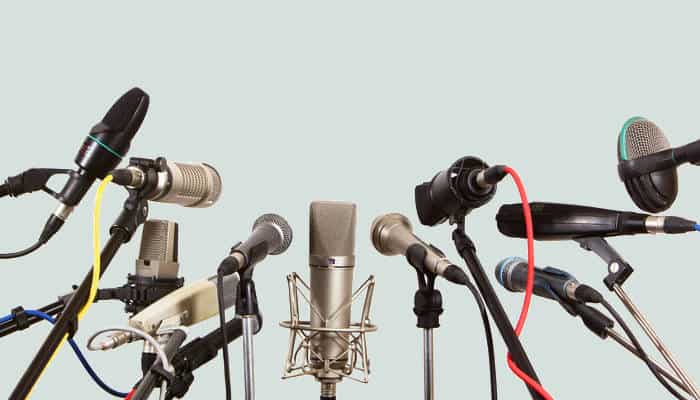Whether you’re a musician looking to record, a podcaster who wants a high-quality product or even someone who teaches languages online, the right microphone is a must. However, there are many different types of microphone, which can make selecting the right one for you that much more challenging.
In this article, we’ll go through what you need to know about different microphone types and brands.
Types of microphones by technology
Before we get into specifics like polarity patterns, we’ll first go over the main types of microphone by technology, as well as what each one is generally suited for.
Dynamic microphones
Dynamic microphones are sturdily built, and they’re frequently used to amplify live vocals. Since they largely record what’s right in front of them, they don’t tend to pick up extraneous noise like condenser microphones and some other types.
The dynamic microphone works via electromagnetic induction. This means that sound that goes into the microphone hits a tiny metal diaphragm, which is attached to a coil. This coil contains a small magnet, which moves as the diaphragm makes the coil vibrate. The magnet’s motion creates an electrical signal, which is what travels through your mic cable to your amplifier or audio workstation.
Common uses of dynamic microphones
Dynamic microphones are ideal for live vocals and they also are frequently used to with loud sound sources like guitar amplifier cabinets and drum kits. However, they aren’t ideal for instruments that produce higher frequencies or harmonics. Consequently, they usually aren’t the best choice for recording acoustic instruments.
Pros of dynamic microphones
- They’re very affordable.
- They are durable and can stand up to road use.
- They work well for a variety of applications.
- They don’t require external power.
Cons of dynamic microphones
- They aren’t the best choice for recording the complexities of many acoustic instruments.
Ribbon microphones
Ribbon microphones are technically a subset of dynamic microphone. Unlike most dynamic mics, most ribbon microphones are able to pick up sound both in front of and behind the microphone. This is because of their design. While dynamic mics have a diaphragm that vibrates a coil, a ribbon microphone has a very thin metal ribbon that is suspended in a magnetic field. The ribbon acts like both the diaphragm and coil in a traditional dynamic microphone.
While they were designed in the 1920s, these microphones aren’t as popular as condensers or dynamic microphones. However, they remain a favorite in some recording studios. Many vintage ribbon mics don’t need external power (and some can even be damaged by phantom power), but some newer models require “phantom power” to operate. (More about phantom power later in this article.)
Common uses of ribbon microphones
Ribbon mics are often described as being able to pick up sounds similarly to the human ear, so they tend to produce very natural-sounding recordings. Many major studios consider them to be the standard when recording the electric guitar. They are also particularly good at picking up the sound of woodwind and brass instruments, and they can record large string sections in a way that feels cinematic.
Some recording engineers also like to use ribbon microphones as overhead recording microphones for drum kits (as opposed to close-recording individual drums with a dynamic microphone).
Pros of ribbon microphones
- They create a very natural-sounding recording.
- They are very versatile.
- Their figure-8 polar pattern means they pick up sound in a similar way to the human ear.
Cons of ribbon microphones
- They often are more expensive than some other microphone types.
- If recording outdoors, they are susceptible to wind interference.
Condenser microphones
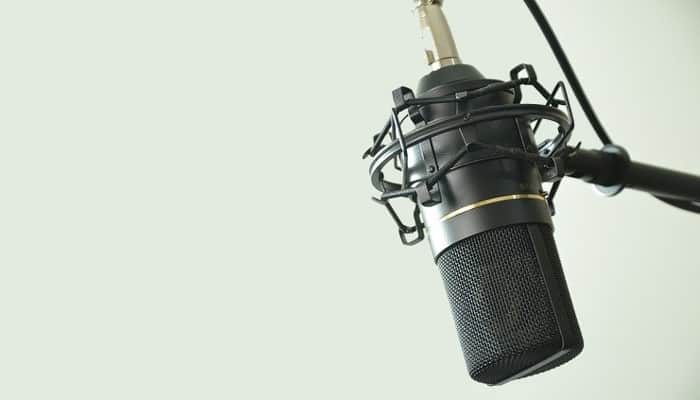
Condenser microphones were first developed around 1916, and they have since become one of the best options when it comes to recording professional-quality audio, especially in the studio. Condenser mics require “phantom power” (more on that in a moment), but they have an expanded frequency range when compared with most dynamic microphones which makes them ideal for recording highly dynamic voices and instruments.
Condenser mics work differently from dynamic and ribbon microphones. They have an internal capacitor (“condenser” was once commonly used to mean “capacitor”), which has an electric current going across it. The capacitor itself has two small plates going across it. One is very thin, and acts like a diaphragm in that it vibrates with sound waves. The vibration changes the distance between the two microphone plates, and this changing distance produces the electrical signal that then travels down your XLR cable.
Common uses of condenser microphones
A condenser mic can capture everything from a low whisper to the complex sounds of many acoustic string instruments. This is due to their higher frequency response. And while they can sometimes pick up more room noise than a dynamic microphone, condensers are known for producing very little noise on their own.
There are two subtypes of condenser mics:
1) Large-diaphragm condenser microphones
These microphones are often larger than small-diaphragm microphones. Their main advantage is the lack of self-noise generated. All microphones will add some amount of noise to your audio recording, but a good quality large-diaphragm condenser will often have half of the self-generated noise of a small-diaphragm condenser.
Large-diaphragm condensers tend to be more affordable (even for high-quality models), and many home recording enthusiasts choose a large-diaphragm microphone as their first studio mic.
2) Small-diaphragm condenser microphones
The small-diaphragm condenser, while it does generate more noise than a large-diaphragm microphone, is often regarded as a superior choice. These mics have a frequency range beyond large-diaphragm condensers, and some can even pick up frequencies beyond the range of human hearing.
They have a more consistent pickup pattern, which results in more consistent audio recordings. And lastly, they’re known for their ability to record sound in a way that seems natural. However, beware of very inexpensive small diaphragm microphones because they are more prone to noise issues and overall poor sound quality. If you need something budget-priced, you will probably get better sound quality from a cheap large-diaphragm mic than you would with a cheap small-diaphragm one.
Pros of condenser microphones
- Expanded frequency range is ideal for nuanced recordings.
- Most (especially small-diaphragm condensers) produce a very natural sound.
- Most have lower self-noise than dynamic and other types of microphone.
Cons of condenser microphones
- A good condenser, and especially a good small diaphragm condenser microphone, is likely to be expensive.
Phantom Power
Condenser microphones require a source of phantom power to work. This power, which is standardized at 48V, is delivered to a condenser microphone through an XLR cable. The voltage is distributed across the mic’s internal capacitor.
There are a couple of different ways you can get phantom power to your mic. You can purchase a phantom power supply, which is essentially a power brick that your mic’s XLR cable plugs into. However, if you record with an audio interface, many (if not most) include microphone jacks with included phantom power. Additionally, some XLR-equipped vocal effects pedals also have built-in phantom power.
Microphone directionality
There are many different types of microphone directionalities. These are often referred to as “polar patterns,” and they refer to the way the microphone picks up sound. Depending on the type of audio you record, you may prefer a mic that records mostly in front of it, or you might want something that can capture a whole room. Here’s what you need to know when it comes to microphone polar patterns.
Omnidirectional
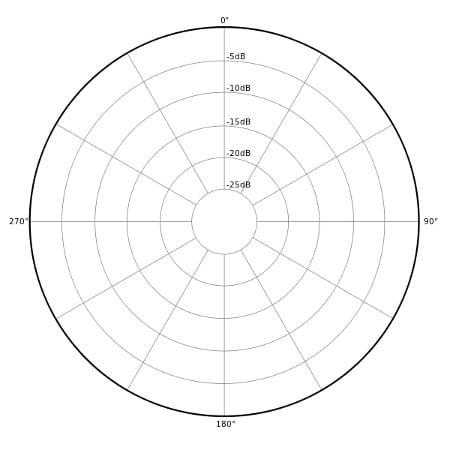
As the name suggests, an omnidirectional microphone is able to pick up sound 360 degrees around it. You can find omnidirectional dynamic mics and condenser mics, although due to their ribbon configuration, ribbon mics can’t be omnidirectional (although they come somewhat close).
An omnidirectional microphone is a good choice if you are trying to record an entire room (and if you don’t want to invest in several microphones). However, because they pick up sound from all directions, these mics do have a tendency to pick up extraneous noise, especially if you’re recording in the field or in a non-treated room.
Bidirectional (Figure-8)
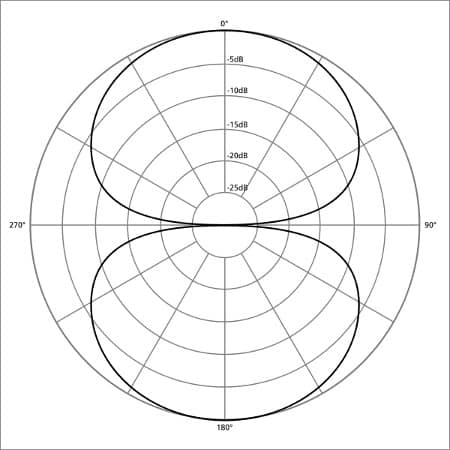
Ribbon microphones are essentially the only microphones with a bidirectional (or figure-8) polar pattern. The small internal ribbon can be vibrated by frequencies both in front of and behind the microphone. However, since the ribbon is too thin to be affected by frequencies from the side, these microphones have a “ring of silence” in their polar pattern. The diagram of a bidirectional polar pattern (shown here) makes the shape of a figure 8.
Bidirectional polar patterns have a unique feature–they are the most sensitive to mic placement. Recording close to the microphone will result in an increase in bass frequencies. Depending on what you intend to record, this could be either an advantage or a disadvantage. However, since these microphones pick up sound like the human ear, they’re useful when you need a natural-sounding recording. They also are good for recording electric guitars, since they seem to get rid of some of the harsh midrange that tends to get picked up.
Unidirectional or Cardioid
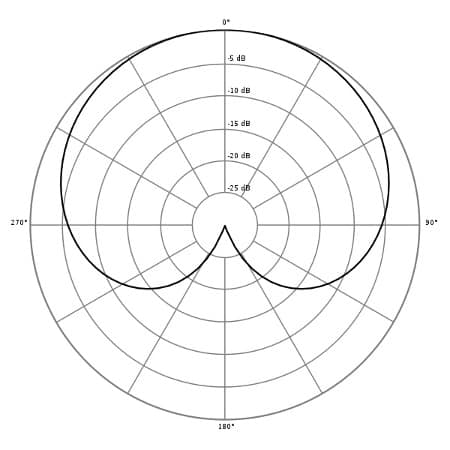
A unidirectional microphone largely picks up sound that’s right in front of it. This is most commonly seen in dynamic mics, although some condensers also have unidirectional polar pattern. This pattern is also known as a cardioid polar pattern because it looks like a heart when diagrammed.
These microphones primarily pick up what’s in front of them, although they will also pick up some sound from the sides. They pick up almost no noise from behind the microphone, which makes them ideal for stage performances–the microphone won’t pick up on the crowd noise behind it, but it will pick up the singer in front of it. Because the cardioid pattern is so good for recording vocals, these microphones are also often used in recording studios.
The Shotgun microphone
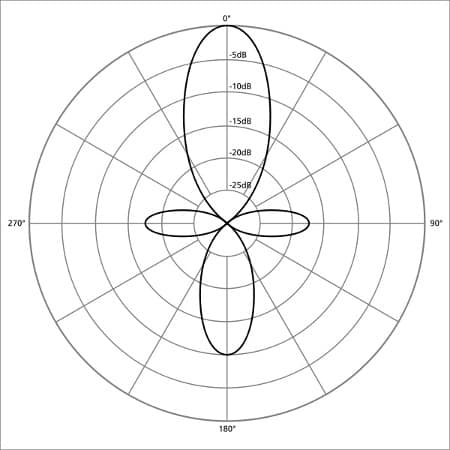
If you’re looking for the most extreme unidirectional recording you can find, a shotgun microphone is an extreme example of a unidirectional polar pattern. As you can see from its polar pattern diagram, this microphone type focuses narrowly on what’s immediately in front of it. And because you need to point a shotgun microphone directly at a sound source (often somewhat far away), this type is good for recording a speech or presentation, even if you’re in a crowd.
Supercardioid
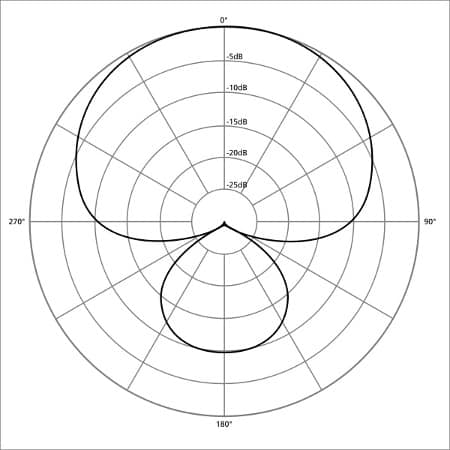
While the cardioid polar pattern is also called “unidirectional,” it’s possible to get a more directional polar pattern with a supercardioid polar pattern. The mic’s focus on what’s in front of it is made even more narrow. However, when you record with a supercardioid microphone, you may notice that the “lobes” that extend behind the microphone are very sensitive to sound. A supercardioid microphone has the advantage of not focusing on room noise. However, especially if you’re new to recording, it may be difficult to place these microphones just right.
Hypercardioid
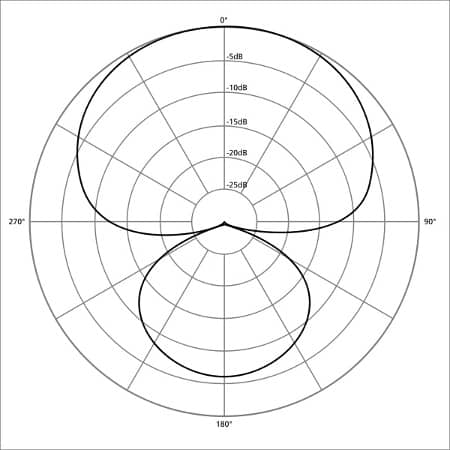
The hypercardioid and supercardioid polar pattern diagrams may look alike at first. And while they are similar, it’s important to note that the hypercardioid is essentially a more focused supercardioid.
Functionally speaking, these are similar to supercardioid microphones, although they’re a good choice if you need to isolate a given sound source from other nearby sounds. However, just like supercardioids, these microphones often will also pick up a small range of sounds behind them, which makes positioning them a challenge.
Types of microphone by connection
Microphones can also be categorized by their connection type. Most professional microphones use an XLR connector, but depending on the type of audio you need, you may find that a different connector type is right for you.
USB microphones
The USB microphone is often a choice for those who are on a budget. They have the advantage of recording directly to a computer thus eliminating the need for an audio interface. However, it’s important to keep in mind that these USB microphones were designed for podcast recording. While they usually record at a high enough quality for the spoken voice, they record at a lower sampling rate than higher-end equipment. This results in less-professional sounding audio. Consequently, a USB mic isn’t usually the right choice for recording music.
Also, USB mics tend to have higher latency than XLR mics. This means that there is likely to be a delay from when the mic picks up a sound to when the sound comes through your headphones or shows up on your audio interface. Depending on what you need to record, this may not be an issue, or it may mean you need to seek out a lower-latency option.
Pros of USB microphones:
- They tend to be very affordable.
- They’re more portable.
- They eliminate the need for an audio interface.
Cons of USB microphones:
- They often don’t produce very high-quality audio.
- Many have latency issues.
- You have less control over your sound.
XLR microphones
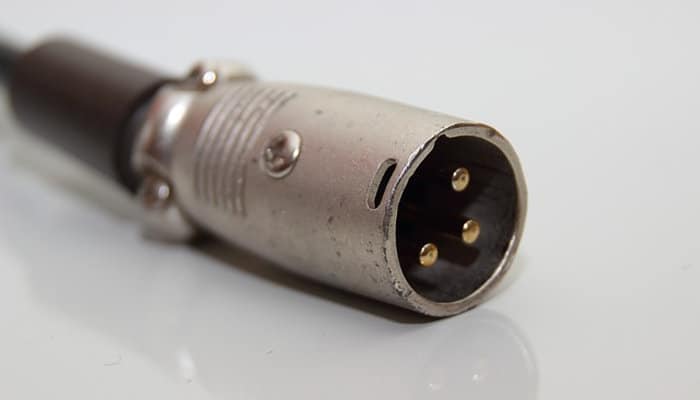
Most XLR mics have a three-pin connection. Because of their high fidelity, low noise, and low latency, these are most people’s first choice when it comes to professional audio. A potential downside is that you can’t simply connect an XLR cable to a computer. – You’ll need what’s called a digital audio interface. While these interfaces do require an upfront cost, they offer you more control over your sound. Many have EQ and volume controls, and some even let you record from multiple microphones at once.
If you want to record with an XLR microphone but only have an interface with a 1/4″ input, the good news is that you can use a transformer or adapter. These adapters connect to the microphone’s XLR cable, change the signal from low impedance to high impedance, and end with a 1/4″ connector. Most of these adapters are relatively inexpensive.
As a general rule, mics equipped with an XLR connector are more expensive than USB mics but if you need professional-quality audio, they’re worth the investment.
Pros of XLR microphones:
- They tend to produce higher-quality audio.
- They allow you greater control over sound.
- They produce very little extraneous noise and are lower latency than other types.
Cons of XLR microphones:
- They are usually more expensive than other types.
- They require use of an audio interface for recording.
Wireless microphones
If you’re giving a speech (or otherwise performing) and want to avoid tripping over cables, a wireless mic is a good investment to make. These microphones come equipped with a transmitter (connected to the mic or worn on the performer) and a receiver (separate). Rather than connecting to the receiver with a cable, these mics transmit the sound wirelessly. You can then connect the receiver to an amplifier or PA system.
Wireless microphone systems have the advantage of a clean aesthetic – You won’t be dealing with very long cables, and you also can feel free to move around when speaking or singing. However, a good wireless system will often be expensive, and you do run the risk of the transmitter picking up other radio frequencies while performing.
Pros of wireless microphone
- They eliminate the need for cables.
- They allow you to move freely when speaking or performing.
Cons of wireless microphones
- Transmitters usually require batteries.
- They can sometimes pick up additional radio frequencies.
- They tend to be more expensive.
TRRS connector
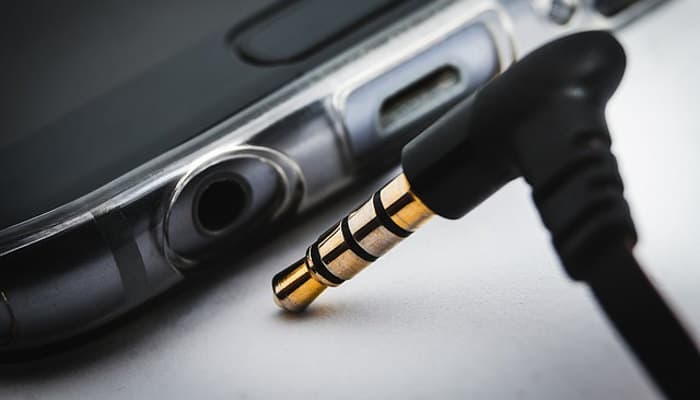
This connector type stands for tip-ring-ring-sleeve, and it’s the most commonly used connector for microphones that are smartphone-compatible. A TRRS connector may look a lot like a 3.5mm headphone connector, but it has two rings around the metal connector instead of one. This is the type of connector you’re most likely to find on microphones marketed as being smartphone compatible.
In terms of sound quality, smartphone-compatible microphones are similar to USB mics. They have the advantages of being highly portable, and most are also very affordable. However, if you need professional-quality audio and have the option of a less-portable setup, you may want to choose an XLR microphone instead.
Pros of TRRS microphones
- Since they connect to your smartphone, they are highly portable.
- You don’t need an audio interface.
- They are usually very affordable.
Cons of TRRS microphones
- Audio quality isn’t as high as some other types.
- You don’t have much control over your sound.
Other common microphone types
If the above microphone types aren’t what you’re looking for, these other common types may prove useful. Here’s what you need to know.
Lavalier microphones
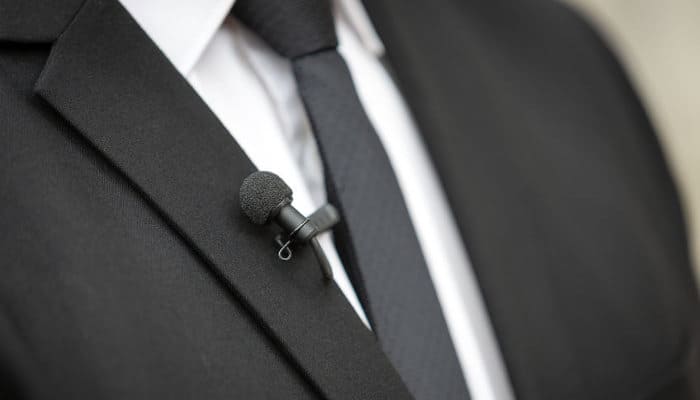
These microphones, also known as lapel microphones, are commonly used when you need to amplify audio without using a more conspicuous microphone (like when you’re interviewing someone for a documentary). You may have also heard them called “clip mics”, “lapel mics”, “body mics” or simply “lavs.”
These microphones are ideal for recording audio for a film, but they aren’t always suited for amplifying audio through speakers. Less-expensive lavalier microphones are often prone to having excessive feedback or white noise (with comparatively little gain on the audio you want to amplify).
While they tend to capture audio well on someone who is sitting or standing still, this type isn’t ideal if you’re walking or moving frequently. If someone wearing a lavalier mic turns their head too far, the mic may struggle to capture what they’re saying. And if they aren’t fitted properly, these mics also may create excess noise by rubbing against clothing.
Pros of lavalier microphones
- They’re less conspicuous.
- They’re good for recording audio when filming.
- You can find decent ones for a cheap price.
Cons of lavalier microphones
- If the person wearing it moves excessively or turns their head, audio may be interrupted.
- Less expensive models often have excessive feedback, making amplified audio relatively poor quality.
Headset microphones
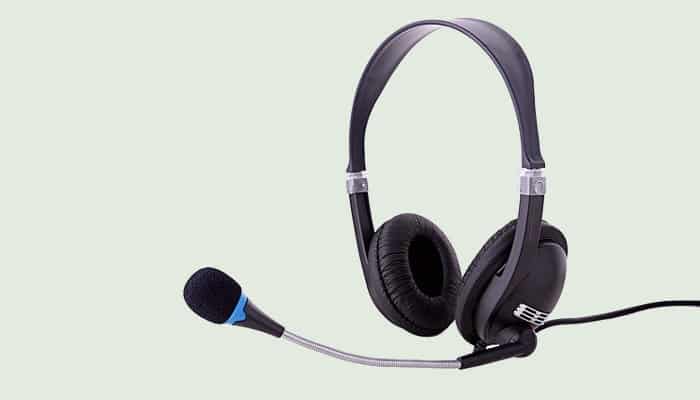
If you’re a gamer, a YouTuber, or someone who teaches languages online via Skype or a similar platform, a headset microphone offers clearer audio than a lavalier mic, and it also gives you the advantage of keeping your hands free.
While most headset microphones won’t produce the professional-quality audio you need for recording voice or live instruments, the fact that they keep the microphone at a set distance from your face means you won’t experience and breaks in what you’re trying to record. These microphones are generally very affordable, especially if you don’t need professional-sounding audio. However, most of them are wired, which can restrict movement.
Pros of headset microphones
- Most are very affordable.
- The microphone is kept in a fixed position, leading to consistent audio.
- They keep your hands free for gaming or typing on a keyboard.
Cons of headset microphones
- Most have a wired connection, which is less convenient if you need to move around.
- They often don’t produce very high-quality audio.
Popular microphones by brand
Many musicians and audio professionals have a brand of microphone they swear by. Generally, you don’t want to choose a microphone only based on brand, but a microphone from a reputable manufacturer is more likely to be durably built and to have clearer sound quality than something from an off brand or unknown manufacturer. Below is a list of some of the most common (and well-reputed) manufacturers:
- Shure
- Sennheiser
- Neumann
- Rode
- Danish Pro Audio (DPA)
- Electro-Voice
- Schoeps
- Audio-Technica
- Royer Labs
- Blue Microphones
Summary
No matter what type of audio you’re trying to record, the type of microphone you choose can make or break the audio quality of your finished product. Be sure to take your time, research your options, and choose a microphone that suits your project. If you found this article useful, be sure to share it!

